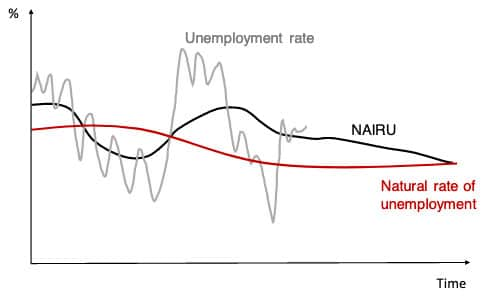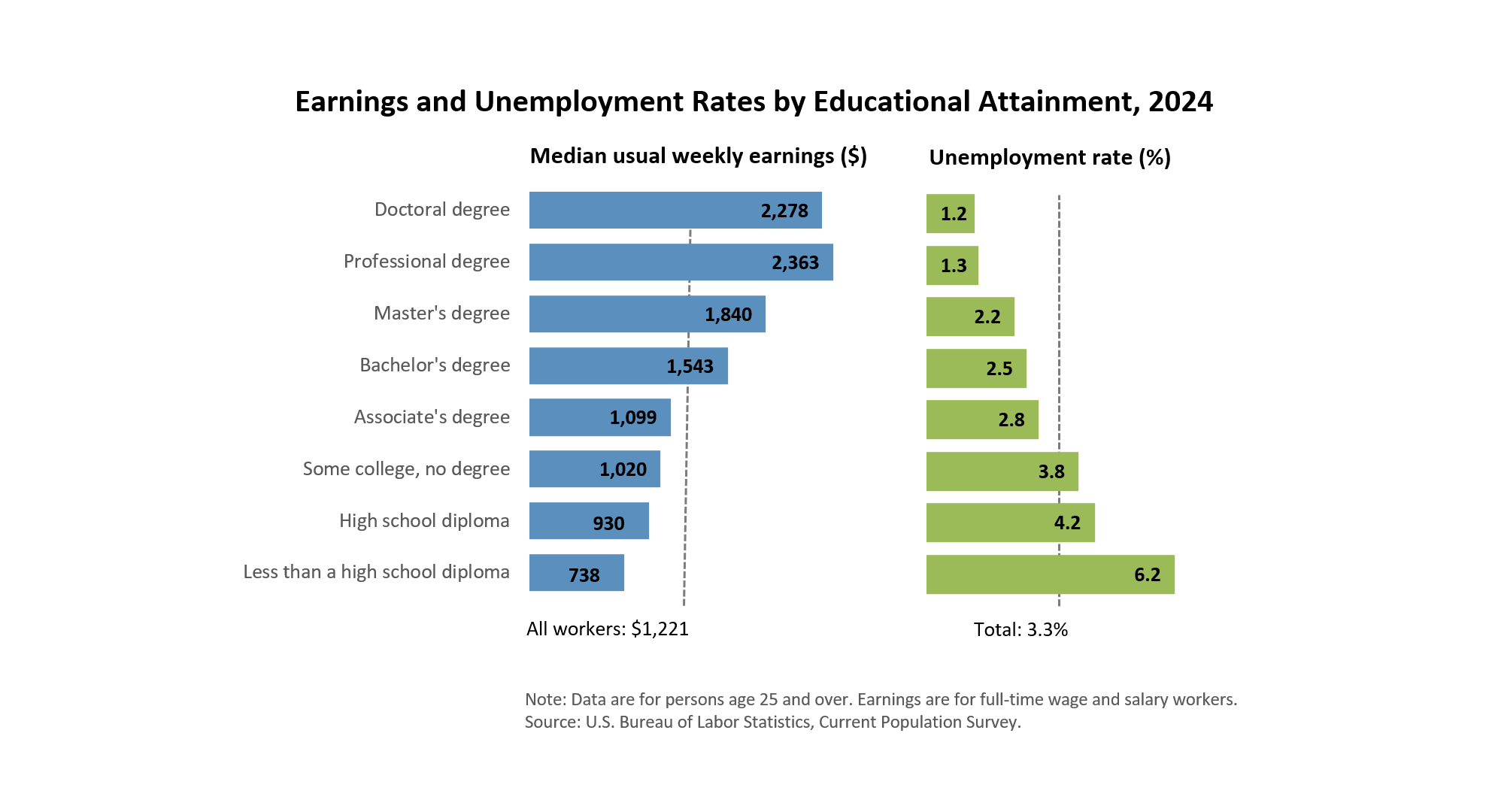AQA Specification focus:
‘The role of supply-side policies in reducing the natural rate of unemployment.’
Reducing the natural rate of unemployment is a central goal of supply-side policies, aiming to enhance labour market efficiency, raise productivity, and foster sustainable long-term economic growth.
Understanding the Natural Rate of Unemployment
The natural rate of unemployment represents the unemployment level that persists when the economy is operating at its potential output, excluding cyclical fluctuations. It includes structural, frictional, and sometimes seasonal unemployment, but not demand-deficient unemployment.
Natural Rate of Unemployment: The long-term level of unemployment determined by structural features of the labour market, occurring when aggregate demand equals aggregate supply.
This means that even in times of economic stability, unemployment cannot fall to zero, as frictions and mismatches in the labour market remain.

This graph shows the actual unemployment rate fluctuating around the natural rate of unemployment, highlighting periods where the economy operates at full potential and when it deviates due to cyclical factors. Source
Supply-Side Policies and Labour Market Efficiency
Labour Market Flexibility
Supply-side measures attempt to improve flexibility within the labour market so that workers and firms can adapt more quickly to changes in demand and technology. Policies can include:
Reducing barriers to hiring and firing (labour market deregulation).
Reforming employment laws to make contracts more adaptable.
Promoting wage flexibility through reduced influence of powerful trade unions.
Education and Training
Improving human capital reduces structural unemployment by equipping workers with the skills required in modern industries. Policies include:
Government investment in vocational training schemes.
Subsidies for apprenticeship programmes.
Expansion of higher education in high-demand fields like STEM.

The chart illustrates that higher educational attainment is associated with lower unemployment rates and higher earnings, emphasizing the role of education in enhancing labour market outcomes. Source
Interventionist Supply-Side Policies
These involve direct government intervention to enhance the skills and employability of workers:
Active Labour Market Policies (ALMPs): Government-provided training, job-search assistance, and work placement schemes.
Regional Policy: Investment in areas suffering from high unemployment to reduce geographical immobility.
Infrastructure Spending: Improved transport and communication networks that expand labour mobility across regions.
Such policies target structural and frictional unemployment by removing barriers that prevent workers from matching with available jobs.
Free-Market Supply-Side Policies
In contrast, free-market measures aim to incentivise private sector behaviour and reduce government interference. These include:
Tax Cuts: Lower income taxes to increase incentives to work.
Welfare Reform: Reducing benefit dependency by ensuring welfare does not exceed wages, strengthening incentives to seek employment.
Privatisation and Deregulation: Encouraging competition and job creation in dynamic markets.
Incentive Structures: The framework of tax, welfare, and regulation that shapes workers’ motivation to participate in the labour market.
By making work more attractive relative to leisure or welfare reliance, such reforms reduce voluntary unemployment and bring more individuals into the labour force.
Reducing Structural Unemployment
Structural unemployment occurs when there is a mismatch between workers’ skills and available jobs. Supply-side policies address this by:
Promoting lifelong learning and retraining for workers displaced by automation.
Incentivising firms to invest in employee skill development.
Supporting research and development to create industries requiring new labour skills.
These policies improve the adaptability of the labour force to ongoing economic change.
Reducing Frictional Unemployment
Frictional unemployment results from workers transitioning between jobs. Supply-side policies aim to reduce search times and barriers by:
Enhancing job information services, such as online platforms connecting employers and jobseekers.
Improving relocation support for workers moving to areas with job opportunities.
Simplifying recruitment processes for firms.
By lowering the time taken for workers to find suitable employment, the natural rate of unemployment decreases.
Long-Term Impacts on the Trend Growth Rate
Supply-side policies not only reduce unemployment but also improve the underlying trend rate of economic growth by:
Increasing labour force participation.
Raising productivity through enhanced skills and efficiency.
Expanding potential output (LRAS) of the economy.
Long-Run Aggregate Supply (LRAS): The productive capacity of an economy when all resources are fully employed at sustainable levels.
As the natural rate of unemployment falls, the economy is better positioned to grow without encountering inflationary pressures.
Criticisms and Limitations
While supply-side policies can reduce the natural rate of unemployment, they face several criticisms:
Time Lags: Education and training policies may take years before results appear.
Cost: Government spending on interventionist measures requires significant resources, potentially worsening the budget balance.
Inequality Effects: Free-market measures such as welfare cuts may disproportionately affect low-income groups.
Effectiveness: Some labour market rigidities, such as cultural barriers to mobility, cannot be easily addressed by policy.
Key Takeaways for AQA Students
Supply-side policies play a critical role in reducing the natural rate of unemployment by addressing structural and frictional causes through both government intervention and free-market reforms. Their effectiveness depends on correct policy design, timing, and balance between efficiency and equity.
FAQ
The natural rate of unemployment is composed mainly of structural and frictional unemployment. Structural unemployment occurs when workers’ skills do not match available jobs, often due to technological change or industrial decline. Frictional unemployment arises from the time it takes individuals to find new jobs when moving between roles or entering the workforce. Seasonal unemployment is sometimes included, but cyclical unemployment is excluded since it relates to demand-side changes.
Welfare reforms aim to adjust incentives to work. If benefits are too generous, individuals may delay entering employment. By tightening eligibility or ensuring that wages are higher than welfare, governments encourage job-seeking.
However, reforms must balance support with incentives. Overly harsh measures risk increasing poverty or underemployment, while carefully designed reforms can reduce voluntary unemployment and bring the natural rate down.
Labour mobility helps workers adjust to changes in demand across industries and regions. Two key forms are:
Geographical mobility: Ability of workers to move between regions where jobs are available.
Occupational mobility: Ability of workers to switch between different job types using transferable skills.
Improving transport infrastructure, affordable housing, and retraining opportunities makes mobility easier. This ensures workers can fill available vacancies more efficiently, lowering long-term unemployment.
Technological change can raise the natural rate in the short run by displacing workers with outdated skills. For example, automation may reduce demand for manual labour.
In the long run, however, technology can create new industries and jobs requiring advanced skills. If governments invest in training and education to help workers transition, the natural rate of unemployment may fall instead. The overall effect depends on how quickly workers adapt.
While effective, supply-side policies have several limitations:
Time lags: Training and education take years to impact.
High cost: Large government spending is often required.
Uncertainty: Structural changes in the global economy may still leave workers unemployed.
Inequality: Deregulation and welfare cuts can disproportionately affect low-income groups.
These factors mean supply-side measures must often be combined with other policies to be most effective.
Practice Questions
Define the natural rate of unemployment. (2 marks)
1 mark for stating that it is the unemployment that exists when the economy is at full capacity or potential output.
1 mark for recognising that it includes structural and frictional unemployment but not cyclical/demand-deficient unemployment.
Explain how supply-side policies can help to reduce the natural rate of unemployment. (6 marks)
1–2 marks: Basic identification of supply-side policies (e.g., education and training, welfare reform, labour market deregulation).
3–4 marks: Explanation of how these policies target structural and/or frictional unemployment (e.g., training improves skills, welfare reform increases incentives to work).
5–6 marks: Developed analysis with clear economic reasoning showing how policies improve labour market flexibility and reduce long-term unemployment. May also include reference to increasing labour force participation or reducing geographical/occupational immobility.

